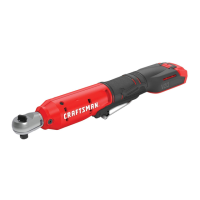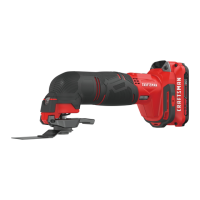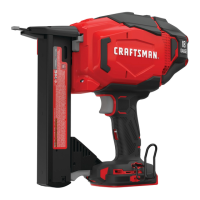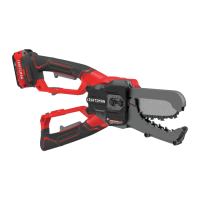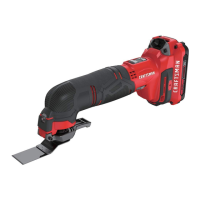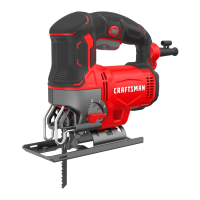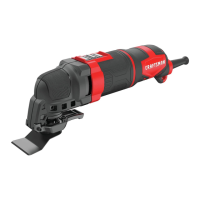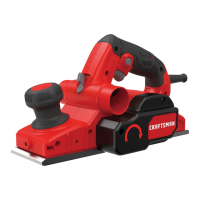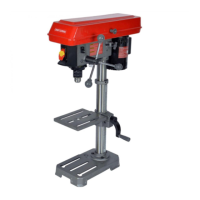7
ENGLISH
READ ALL INSTRUCTIONS
Important Safety Instructions for All
Battery Packs
WARNING: Read all safety warnings, instructions,
and cautionary markings for the battery pack,
charger and product. Failure to follow the
warnings and instructions may result in electric
shock, fire and/or seriousinjury.
• Do not charge or use the battery pack in explosive
atmospheres, such as in the presence of flammable
liquids, gases or dust. Inserting or removing the battery
pack from the charger may ignite the dust orfumes.
• NEVER force the battery pack into the charger. DO
NOT modify the battery pack in any way to fit into a
non‑compatible charger as battery pack may rupture
causing serious personal injury. Consult the chart
at the end of this manual for compatibility of batteries
andchargers.
• Charge the battery packs only in
CRAFTSMANchargers.
• DO NOT splash or immerse in water or otherliquids.
• DO NOT allow water or any liquid to enter batterypack.
• Do not store or use the tool and battery pack in
locations where the temperature may reach or
exceed 104°F (40°C) (such as outside sheds or metal
buildings in summer). For best life store battery packs in
a cool, drylocation.
NOTE: Do not store the battery packs in a tool with
the trigger switch locked on. Never tape the trigger
switch in the ONposition.
• Do not incinerate the battery pack even if it is severely
damaged or is completely worn out. The battery pack
can explode in a fire. Toxic fumes and materials are created
when lithium‑ion battery packs areburned.
BATTERIES AND CHARGERS
The battery pack is not fully charged out of the carton.
Before using the battery pack and charger, read the
safety instructions below and then follow charging
proceduresoutlined. When ordering replacement battery
packs, be sure to include the catalog number andvoltage.
sfpm ................... surface feet per
minute
SPM .................... strokes per minute
A ......................... amperes
W ........................watts
Wh ......................watt hours
Ah ....................... amp hours
or AC ...........alternating current
or AC/DC .... alternating or direct
current
...................... Class II Construction
(double insulated)
n
o
.......................no load speed
n .........................rated speed
PSI....................... pounds per square
inch
......................earthing terminal
.....................safety alert symbol
..................... visible radiation
do not stare into
the light
..................... wear respiratory
protection
..................... wear eye protection
..................... wear hearing
protection
..................... read all
documentation
The label on your tool may include the following symbols. The
symbols and their definitions are asfollows:
V ......................... volts
Hz .......................hertz
min ..................... minutes
or DC ......direct current
...................... Class I Construction
(grounded)
…/min ..............per minute
BPM .................... beats per minute
IPM ..................... impacts per minute
OPM .................... oscillations per
minute
RPM .................... revolutions per
minute
Jig Saw Safety Warnings
• Hold the power tool by insulated gripping surfaces,
when performing an operation where the cutting
accessory may contact hidden wiring. Cutting
accessory contacting a "live" wire may make exposed metal
parts of the power tool "live" and could give the operator
an electricshock.
• Disconnect power before using tool near live wires or
where there may be hidden wiring. Cutting accessory
contacting a “live” wire may make exposed metal parts of
the power tool “live” and could give the operator an electric
shock.” Always check for hidden wiring, gas lines, or other
utilities before performing any material cutting or removal
operations with thetool.
• Use clamps or another practical way to secure and
support the workpiece to a stable platform. Holding
the workpiece by hand or against your body leaves it
unstable and may lead to loss ofcontrol.
• Wait for the cutter to stop before setting the tool
down. An exposed cutter may engage the surface leading
to possible loss of control and seriousinjury.
• Do not “jam” the saw blade or apply excessive
pressure. Do not attempt to make an excessive depth
ofcut.
• Keep your hands away from cutting area. Do not reach
under the material beingcut.
• Do not use dull or damaged blades. Bent blade can
break easily or cause kickback. Exercise extreme caution
when handling the accessories. The accessories are very
sharp. Wear protective gloves when changing cutting
accessories. Accessories become hot after prolongedusage.
• Use the appropriate dust extractor vacuum to remove
the vast majority of static and airborne dust. Failure
to remove static and airborne dust could contaminate the
working environment or pose an increased health risk to
the operator and those in closeproximity.
• Use clamps or other practical ways to secure and
support the workpiece to a stable platform. Holding
the work by hand or against your body is unstable and may
lead to loss of control and injury.
• Air vents often cover moving parts and should be
avoided. Loose clothes, jewelry or long hair can be caught
in movingparts.
CAUTION: When not in use, place tool on its side
on a stable surface where it will not cause a
tripping or falling hazard. Some tools with large
battery packs will stand upright on the battery pack
but may be easily knockedover.
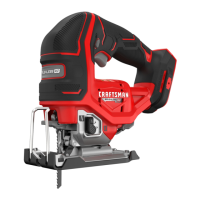
